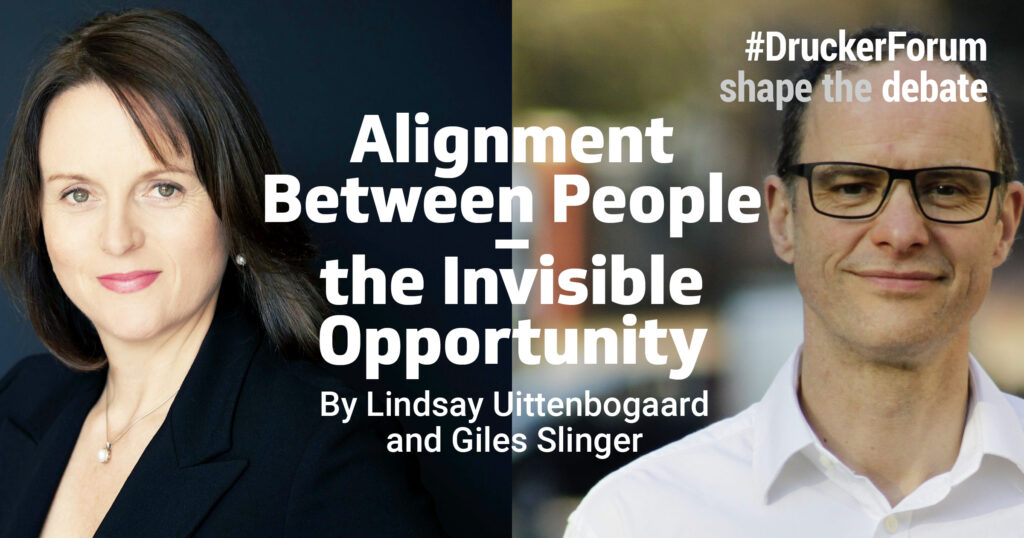
Typically, people think of ‘alignment’ in literal terms: to ‘line things up’. For an organization, this can mean connecting purpose with strategy and values, and connecting job requirements with capabilities and goals. But what about alignment between people? Alignment between people – for effective decisions and actions – is vital for change, especially at the top, where levels of influence are at their highest. Here we dig into what human alignment means, why it is a source of competitive advantage, and how to deal with it.
Misalignment costs
People have their biases, make assumptions, and form unique interpretations. Especially in diverse, dynamic, complex, and remote or hybrid working environments, misalignment happens. Think of where misalignment has caused issues in your own organization: when decisions and actions don’t line up, the consequences can add up to colossal proportions.
Misalignment used to be known as ‘the white space’ or ‘noise’. It’s difficult to deal with because it’s often hidden: you can’t see what other people are thinking? And it’s messy: attempts to ‘align’ in conversation usually end up with people avoiding the real issues because they don’t want to point the finger of blame, they don’t want to look stupid, or because they haven’t had a chance to think things through. Either that or you get stuck in the weeds, moving around from root cause analysis to implications, to requirements, to solutions, wading through recollections and expectations that would take far too long to iron out properly.
Poorly aligned companies have 50% lower returns on invested capital and 18% overall in EBITDA, according to research from McKinsey (2017). Is it just part of life in business or what can you do?
Human alignment is evolving
Here are five ways people you can intervene to help people align, starting with the obvious and most common, moving to those just emerging:
- Ownership alignment – where parties’ interests are aligned shareholdings through founding agreements and incentive plans. Privatisation started this in the 1980s, and there is still work to do – e.g. in the Netherlands, where The Share Council and Fledgerr encourage ESOPs.
- Hierarchical alignment – where terms of employment, roles, and goals, are directed in top-down reporting structures. Tools to provide clarity on organization structures such as orgvue.com are widely used.
- Task alignment – ‘let the work do the work’, as Rosabeth Moss Kanter said. Kanban platforms such as Trello or Alkemio enable people to organize, share information on their work. This encourages clarity on purpose, priorities, and progress for better collaboration.
- Network alignment –by identifying and harnessing influencers between groups, network mapping ‘gives people the power of the organisation.’ The Network Lab or Peerdom, for example, builds a new level of power to engage and deliver.
- Perception alignment – this is, in our view, the missing and central piece of the human alignment landscape. By comparing perceptions and ideas in a structured way, people can measure differences and identify when they need to reshape their collective understanding of opportunities. Organisations can move more quickly from a feeling of misalignment to a measure of how much misalignment there is, where, and on what issues.
The empowered and aligned employee is an entrepreneurial, interconnected human.
We know from research that when people are empowered and feel psychologically safe at work, they become more innovative, more contributory, more entrepreneurial. Neuroscience also tells us that people need to make sense of things on their own terms in a social process. They cannot simply be told to align. They need the space to recognize ‘reality’ and their place in that through dialogue.

The more human alignment that can be created, the better your organization performs. We know that this is because people who are aligned can cope in novel situations by making decisions and taking actions that are congruent with their shared goals. So, if your organization can measure alignment and act to increase it, it will be a source of competitive advantage.
Advanced Human Alignment
The big misconception is that alignment means agreement on content. Particularly on the last two dimensions, alignment can also mean appreciation of differences towards consensus on the way forward (also a form of alignment).
Research from Stanford University Graduate School’s Amir Goldberg recently found the most successful teams use differences in perceptions to gather ideas then seek convergence in perceptions to co-ordinate action. Matthew Syed has similarly described the benefits of ‘Rebel Ideas’ at the ideation stage.
So, if you feel your organisation is not moving forward as it should, trying asking ‘how aligned are we?’ – because the answer could be to fix things, at the level of systems or incentives, or it could be to identify and measure key alignment gaps, so they can be addressed.
About the authors:
Giles Slinger is a recovering economist, consultant, and start-up founder. Lindsay Uittenbogaard is CEO and founder of Mirror Mirror. Both are based in the Netherlands.

